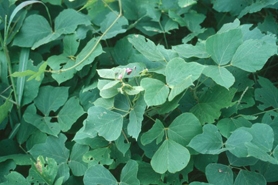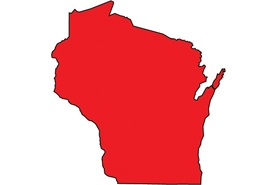Kudzu
(Pueraria montana or P. lobata)
Perennial, deciduous, semi-woody climbing vine; stems are yellow-green and are covered with golden and silver hairs. It can grow up to 1’ per day and 60’ per season and is also able to produce up to 30 vines from one root crown.
Other names for this plant include:
- Common names: Vine-that-ate-the-south, foot-a-night vine, Japanese arrowroot
- Scientific names: P montana var. lobata; P. montana var. montana
Classification in Wisconsin: Prohibited
- Ecological Threat
-
- It is commonly found infesting forest edges, abandoned fields, roadsides and other disturbed areas.
- Girdles and blankets trees and shrubs by climbing them to the root crown, increasing the chances of the trees being pulled down due to their weight.
- Identification
-
Leaves: Alternate leaves are compound and comprise three broad, pointed slightly lobed leaflets with golden hairs.
Flowers: Fragrant purple flowers with a yellow middle occur in leaf axils in long upright panicles from June-September.
Fruits & seeds: Flat, brown, golden-haired pods form clusters and hold 3-10 seeds.
Roots: An edible, tuberous root that can be as big as 12’ deep and 400 pounds. Reproduces from runners, rhizomes and vines that root at the node and seeds.
Similar species: Large poison ivy (Toxicodendron radicans; native) leaves and vining stems look identical to grown kudzu but are hairless on the upper leaf surface. The lower leaf surface is slightly hairy and pale green. Native grapes (Vitis spp.) have similar growing habits, but the leaves of grapes have long petioles and are hairless on the upper leaf surface. Grapes also have tendrils that aid in climbing.
- Distribution
-
Currently, there have been no reports of kudzu in Wisconsin. Have you seen it? Please send us a report.
- Control
-
Mechanical: Mow small infestations every month for several growing seasons. Cuttings should be burned or bagged and disposed of in a landfill.
Chemical: Cut stem treatment or foliar spray with glyphosate, clopyralid, or triclopyr.
- Resources
- Sources for content:
- Czarapata, Elizabeth; Invasive Plants of the Upper Midwest: an illustrated guide to their identification and control. The University of Wisconsin Press. 2005. Pg. 131-132



